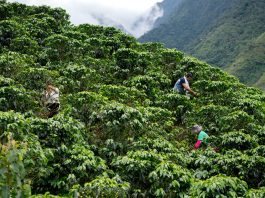Hanna Neuschwander from World Coffee Research discusses some of the current issues facing the coffee industry.
The global coffee crop is increasingly threatened by climate change, diseases and pests. It also appears as if Coffea arabica (C. arabica), which accounts for 70% of coffee global production, is one of the least genetically diverse crop species in the world. To make matters worse, the limited coffee genetic resources we have are being lost at a rapid pace. Unfortunately, most of the main gene banks for coffee (called ex situ collections) are in disrepair. Coffee gene banks are all field gene banks, collections of living plants, which are expensive to maintain. Many critical coffee genetic resources have already been lost as trees die for lack of care and maintenance. Once a tree dies, if there is no duplicate, its unique genetics are lost forever. Rising temperatures and extreme weather are putting pressure on these essential assets; many field gene banks are located in zones that are considered inappropriate for healthy coffee. In addition to this, C. arabica’s natural habitat in the highland forests of Ethiopia (the world’s only in situ collection) is rapidly disappearing. These losses, combined with coffee’s lack of genetic diversity, severely threaten the future of the crop.
The existing gene banks do the best they can with extremely limited resources, but these limitations have practical consequences. For example, most of the gene banks do not have publicly accessible catalogues of the materials contained in the bank (this is equivalent to having a library full of books with no searchable catalogue). The materials in these collections have not been fully characterised using newer, cheaper genotyping methods; it is assumed that there are many duplicates in some of these collections, but without genotyping we can’t be sure. Moreover, only the CATIE coffee germplasm bank in Costa Rica is party to an international treaty on the open sharing of genetic resources for the improvement of crops. CATIE’s participation in the Plant Treaty enables breeders from around the world to obtain and work with genetic material to make critical improvements to the coffee crop. The other 18 coffee germplasm banks, many of which contain novel species and varieties not held in the CATIE collection, do not participate in the Plant Treaty.
The first step to improving this situation is to create a vision for how it could be better. In 2017, World Coffee Research (WCR) and the Global Crop Diversity Trust did just that, creating a global coffee conservation strategy to provide a roadmap for the future sustainability of the crop and the livelihoods dependent on it. Working together with the Crop Trust, WCR reviewed the world’s coffee germplasm collections—stored in field gene banks and in native forests around the world—and assessed the challenges that coffee and its genetic resources face, including an assessment of the significant gaps in collections and their links to in situ conservation. The project identified high priority actions that need to be taken and ensure commitment by the coffee industry to invest in these actions, securing the long-term conservation of globally available coffee through the Crop Trust’s Crop Diversity Endowment Fund. The most important hurdle remains, which is funding. The strategy calls for establishing a $25m(~€23m) endowment to fund the four most essential collections in perpetuity. However, very little of that money has been raised so far.
Accelerating the creation of different coffee varieties
Building the next generation of coffee varieties and sustaining the industry’s genetic resources and breeding pools is a major, cross-cutting initiative too big for an individual institute to undertake. By drawing on the latest breakthroughs in coffee genetics and working in collaboration with individual country breeding programs, WCR is accelerating the creation of coffee varieties to meet the challenges of the 21st century.
The cornerstone of WCR’s strategy is the creation of a network of regional breeding hubs that countries, research institutes, and private sector partners can utilise in order to accelerate the pace of coffee genetic improvement. Hubs have a collaborative design and governance among participating partners and are co-ordinated locally by a host institution. To each hub, WCR contributes the results of advance research, including:
- Genes and molecular markers to accelerate molecular breeding approaches (cutting in half the time to create new crosses);
- Training for local breeders on advanced breeding techniques;
- Improved breeding populations, including the WCR Core Collection, 100 genetically diverse C. arabica plants that can be used to develop new high-performing hybrid varieties that combine maximum genetic diversity with high performance (new plants in five years); and
- All these programs are underpinned by the WCR Sensory program that ensures the highest cup quality through early generation and parental screening.
Participants to each hub bring their own locally available, top-performing plant material and, using the above, create crosses that are adapted to the local requirements.
WCRs Nursery Development Program
Moreover, one of the essential, and largely invisible, problems facing the coffee industry is the lack of a professional coffee seed sector. WCR’s researchers believe the vast majority of coffee trees produced in nurseries annually are lower quality than they could/ should be. With each poor-quality seedling planted in their fields, farmers lock in lower production potential for decades to come, which powerfully reinforces the ‘poverty trap’ faced by smallholder farmers in particular. Improving nursery production practices has the potential to dramatically improve the productivity and profitability of coffee farms globally and to ensure that the genetic gains coming from new/improved varieties are able to reach farmers.
WCR’s Nursery Development Program is aimed at building the capacity of small entrepreneurial and cooperative nurseries to produce adequate volumes of genetically pure and healthy seedlings to small farms and farmers. Nursery staff are trained at the nursery using a WCR-developed manual of best practices for producing genetically pure and healthy seedlings, as well as on good business practices. Nursery staff are trained-as-trainers for lasting impact.
Deciphering the biology of coffee leaf rust
Another issue facing the coffee industry is coffee leaf rust. Finding better solutions for coffee leaf rust (H. vasatrix) is essential as it is the most economically damaging disease affecting coffee. Despite the fact that coffee producers have been living with coffee leaf rust for nearly 200 years, serious questions remain unanswered regarding its biology. Successful disease management and breeding programs require understanding rusts’ reproductive strategies (including current genetic diversity and capacity for creating new genetic diversity) and its dispersal biology and history. Yet none of these questions has been conclusively resolved or rigorously tested. With WCR, rust expert Dr Aime of Purdue University is working to develop a deeper understanding of the biology, reproductive strategies, and genetic diversity of coffee leaf rust in order to determine whether H. vastatrix has a sexual stage, and if so where it occurs, and map the global movement of H. vastatrix both historically and leading up a disastrous epidemic in Latin America in 2012.
As of now, Aime’s team has produced a new genome assembly and identified 15 SSR markers that can be used for rapid genotyping of H. vastatrix and is also finalising the assembly of the first global population analysis of H. vastatrix from 934 samples collected in 14 countries (publication forthcoming). This research aims to provide the necessary data for breeders to produce more durable resistance in arabica cultivars. It also aims to provide the data necessary for modelling the variables involved in producing disease epidemics. More resistant cultivars and knowledge on how to better manage farms to prevent outbreaks will provide farmers with a tool to lower their risk and increase productivity and income. Other potential applications include the development of rapid tests to quickly and cheaply test rust spores on coffee farms to determine which race of rust is present.
Hanna Neuschwander
Communications Director
World Coffee Research
Tweet @WCoffeeResearch
https://worldcoffeeresearch.org/
Please note, this article will also appear in the first edition of our new quarterly publication.









